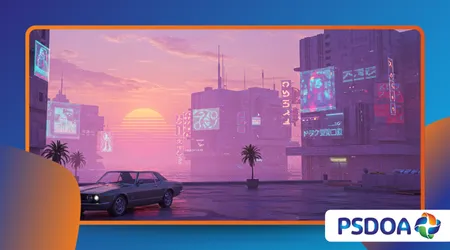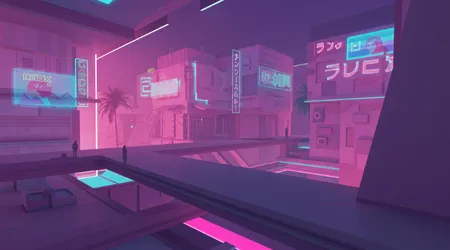Vaporwave Architecture: When Design Meets Anti-Capitalism

The internet subculture known as Vaporwave is more than slowed-down 80s Muzak and glitch art; it’s a profound critique wrapped in a nostalgic aesthetic. At its core, Vaporwave Architecture is the movement’s physical manifestation.
Anúncios
It is a visual language that repurposes the bombastic, often sterile monuments of late capitalism think mirrored skyscrapers, empty malls, and endless pastel-hued office parks. This design philosophy utilizes irony and decay to expose the failures of consumerist utopianism.
This examination delves into how this aesthetic, rooted in the 2010s, remains relevant in 2025. It is a highly intelligent, visually rich commentary on economic failure and corporate emptiness.
We dissect the elements, from Roman busts to fluorescent lighting, that define Vaporwave Architecture and explore its surprisingly deep anti-capitalist critique. This design is a form of passive, yet potent, rebellion.
What are the Core Elements of Vaporwave’s Design Language?
Vaporwave’s aesthetic is built upon a specific, often contradictory, set of visual motifs drawn primarily from the 1980s and 1990s. Understanding these elements is key to deciphering the movement’s message.
Anúncios
Why the Obsession with Pastel and Neon?
The pervasive use of saturated pastel colors (pinks, teals, lavenders) and vibrant neon lighting directly references the hopeful, optimistic branding of the early digital age. This aesthetic was the corporate face of consumer technology.
Vaporwave uses these colors ironically. They are the faded, slightly decayed remnants of a future that never fully materialized.
This juxtaposition creates a sense of melancholic nostalgia, the feeling of remembering a promise that was broken. The vibrant colors in Vaporwave Architecture are a visual lie, a veneer over corporate emptiness.
++ From Underground to Mainstream: The Lifecycle of Subcultures
What is the Significance of Roman Statues in Vaporwave?
The inclusion of classical Greek and Roman sculptures is central to the movement. These marble forms, often rendered in low-resolution digital space, symbolize the collapse of empires and the cyclical nature of civilization.
They represent a peak of human achievement placed ironically within the context of a decaying, disposable corporate culture.
The classical bust perfect yet broken becomes a comment on the fleeting nature of modern economic dominance. The clash between eternal art and disposable technology defines the look of Vaporwave Architecture.

How Does Vaporwave Critique Modern Capitalism?
The design isn’t just cool imagery; it’s a sophisticated visual argument. Vaporwave Architecture employs themes of emptiness and automation to criticize modern financial structures.
The Aesthetics of Corporate Empty Space
Vaporwave frequently depicts vast, empty corporate plazas, mirrored office buildings, and vacant shopping malls. These spaces, built for perpetual activity and commerce, are shown devoid of human life.
Also read: Skateboarding as a Cultural Rebellion Then and Now
Why Does the Empty Mall Represent Economic Failure?
The abandoned or underutilized mall is the movement’s most powerful symbol. It represents the promise of limitless consumption that ultimately failed, leaving behind massive, costly structural monuments.
These structures in Vaporwave Architecture are monuments to obsolescence. They underscore the cyclical boom-and-bust nature of consumerism, where yesterday’s cathedral of commerce is today’s decaying relic. The emptiness speaks louder than any protest sign.
Read more: A Look Into “Dead Internet Theory” Subreddits
The Reflection of Glitch and Decay
The intentional use of visual glitch effects and decay (flickering screens, stained marble) acts as an artistic sabotage of the clean, perfect corporate image. It suggests the underlying systemic flaws of the late 20th-century capitalist system.
This digital deterioration implies that the entire sleek facade of corporate dominance is fundamentally fragile and prone to collapse. The glitch is the moment the machine fails to hide its true, broken nature, proving that Vaporwave Architecture is inherently critical.
Where Can We See Vaporwave Architectural Principles in Reality?
While the purest form of Vaporwave Architecture exists primarily in digital renderings, its influence is visible in physical spaces often unintentionally.
What Real-World Buildings Exemplify the Vaporwave Aesthetic?
Certain commercial and public spaces built during the 1980s and 1990s, particularly those designed with maximalist Postmodern flair, unintentionally embody the aesthetic.
The Corporate Campus and Postmodern Public Spaces
Think of structures utilizing geometric shapes, pastel tiles, atrium fountains, and glass blocks styles once intended to project prosperity. Today, these buildings, often aging and under-maintained, possess the exact melancholic, slightly dated feel that Vaporwave appropriates.
Example 1: The interior of the old Hyatt Regency Chicago (especially pre-renovation atrium areas) with its vast, mirrored walls and geometric lighting schemes, perfectly captures the grand, impersonal scale Vaporwave satirizes.
Example 2: Many former regional bank headquarters with pink granite and towering columns built in the 90s, now partially vacant, serve as accidental monuments to the financial exuberance of that era. These places show the accidental presence of Vaporwave Architecture in the real world.
The Shift from Productive Space to Nostalgic Ruin
The architecture captures a moment when digital technology promised complete liberation but delivered corporate servitude and endless data consumption. The spaces are beautiful, but functionally obsolete.
This represents the shift from high-modernist functionalism to a design focused purely on image and consumption. Vaporwave Architecture captures the ruin of this image, making us question the original purpose of the grandiosity.
Statistic: A 2024 urban studies report tracking major metropolitan areas in the US found that the vacancy rate in suburban office parks and older ’90s-era shopping centers reached a 30-year high of 21.3%. These physically empty structures provide real-world canvases for Vaporwave’s themes of corporate decay.
Summary of Vaporwave Architectural Critique
| Design Element | Primary Symbolism | Anti-Capitalist Critique | Key Location in Vaporwave Architecture |
| Pastel/Neon Colors | Early Digital Optimism, Corporate Branding | Faded promise of a technological utopia. | Office Atriums, Retail Storefronts |
| Roman/Greek Statues | Classical Eternity, Human Peak | Irony of eternal art juxtaposed with temporary consumer culture. | Plazas, Interior Lobbies |
| Empty Malls/Spaces | Limitless Consumption, Commerce | Monuments to economic failure and subsequent obsolescence. | Interior Vistas, Parking Garages |
| Glitch Effects | Digital Error, Imperfection | Exposes the underlying systemic fragility of the “perfect” corporate system. | Digital Renderings, Flickering Signage |
Conclusion: The Cultural Resonance of Ironic Design
Vaporwave Architecture is a crucial modern lens through which we view the broken promises of a hyper-consumerist society. It doesn’t offer a political solution; instead, it offers a form of aesthetic resistance.
By making the symbols of corporate power feel alien, ironic, and decaying, the movement disarms them. It forces us to see the beautiful, yet utterly cold, monuments built in the name of profit. The enduring power of Vaporwave Architecture lies in its ability to transform nostalgia into a critical tool.
Do you see the melancholy irony when you look at an abandoned mall now? Share your thoughts on which real-world building most embodies the Vaporwave aesthetic in the comments below!
Frequently Asked Questions (FAQs)
Q: Is Vaporwave Architecture a real building style that architects use?
A: Not formally. Vaporwave Architecture is primarily an aesthetic movement expressed through digital art, music videos, and rendering.
It critiques, rather than creates, physical architecture, though its visual themes are often found unintentionally in aging 80s and 90s Postmodern buildings.
Q: Why is the music always slowed down in Vaporwave?
A: The slowed-down (chopped and screwed) effect applied to elevator music or corporate jingles satirizes the omnipresent, bland soundtrack of consumer spaces.
The drag effect makes the music sound detached and hypnotic, intensifying the feeling of emptiness inherent in Vaporwave Architecture.
Q: Can a new building intentionally be Vaporwave?
A: While some modern designers draw inspiration from its color palette or geometric forms, creating a truly authentic Vaporwave Architecture structure is paradoxical.
The aesthetic relies on the decay and obsolescence of its source material to deliver its critique, something new construction cannot replicate.
